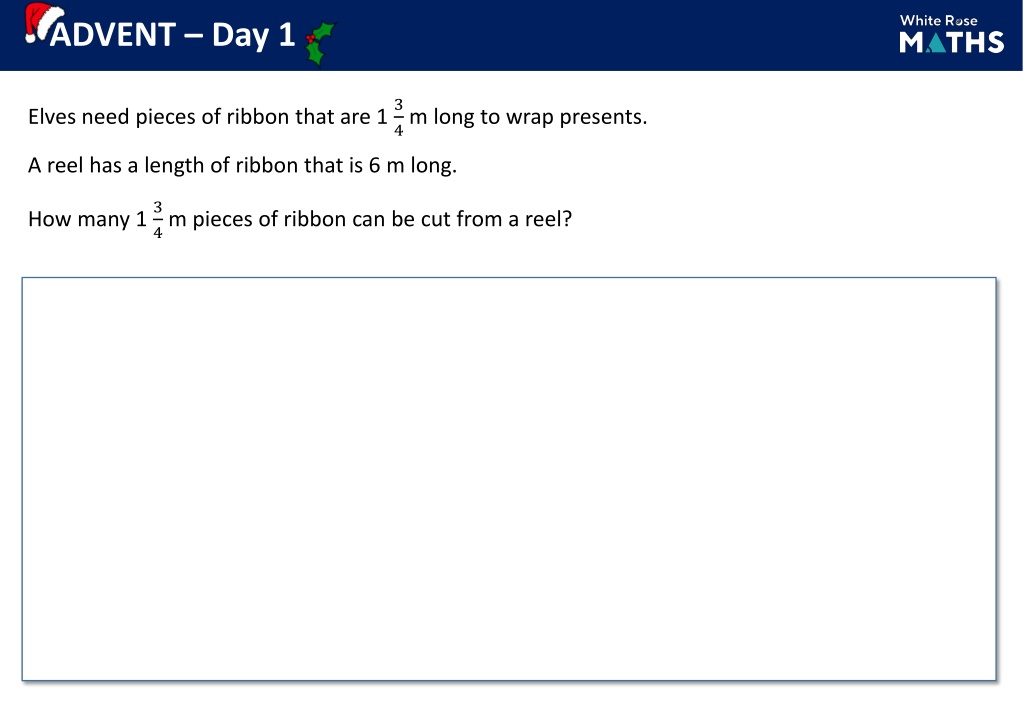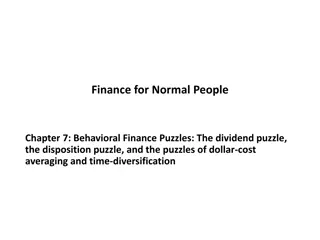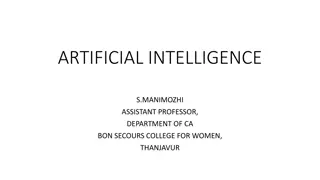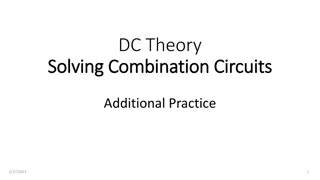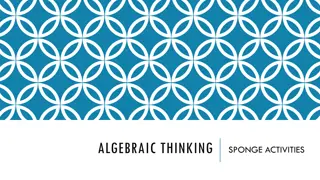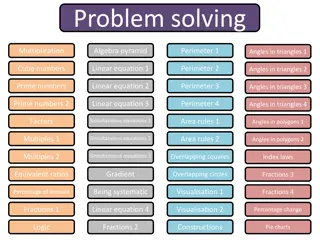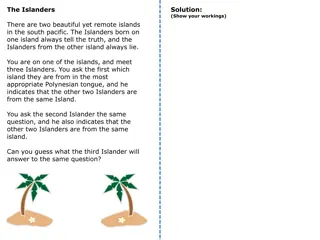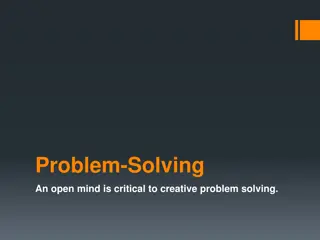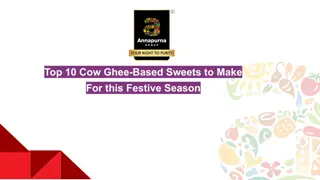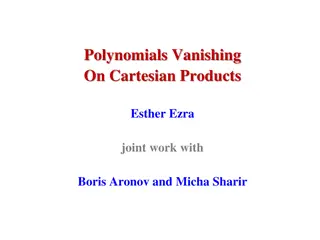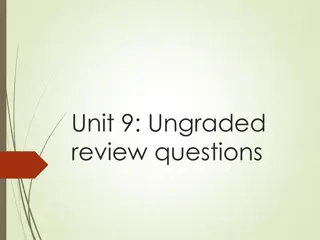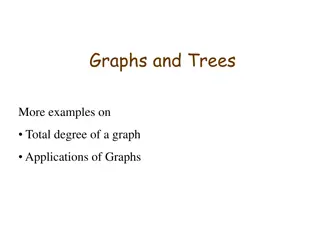Festive Puzzles and Problem Solving Challenges
Join in the holiday fun with a series of festive puzzles and challenges! Help the elves cut the right length of ribbon, guide Santa on his present-delivery route, and ensure there's enough wrapping paper for a special gift. These engaging activities will keep you entertained and sharpen your problem-solving skills throughout the advent season.
Download Presentation

Please find below an Image/Link to download the presentation.
The content on the website is provided AS IS for your information and personal use only. It may not be sold, licensed, or shared on other websites without obtaining consent from the author.If you encounter any issues during the download, it is possible that the publisher has removed the file from their server.
You are allowed to download the files provided on this website for personal or commercial use, subject to the condition that they are used lawfully. All files are the property of their respective owners.
The content on the website is provided AS IS for your information and personal use only. It may not be sold, licensed, or shared on other websites without obtaining consent from the author.
E N D
Presentation Transcript
ADVENT Day 1 Elves need pieces of ribbon that are 1 3 4m long to wrap presents. A reel has a length of ribbon that is 6 m long. How many 1 3 4m pieces of ribbon can be cut from a reel?
ADVENT Day 1 Elves need pieces of ribbon that are 1 3 4m long to wrap presents. A reel has a length of ribbon that is 6 m long. How many 1 3 4m pieces of ribbon can be cut from a reel? 1 3 4=7 6 7 4 4 1 3 4=7 4 6 7 4 6 1 7 4=6 1 4 7=24 7 24 7= 3 3 7 3 pieces of ribbon.
ADVENT Day 1 The abstract calculation can be tricky for some students to understand. Using bar models can help students visualise how many 7 4 go into 6. Highlight the importance of converting to an improper fraction first as often students will try and divide the integer and fraction separately.
ADVENT Day 2 Here is map of some locations that Santa and his reindeer have to visit to deliver presents. L C E J A U B R M G D S T N F H Santa starts from one of the letters and moves to a new location after each move. He travels: 4 squares West 2 squares South 4 squares East 2 squares South Which letters did Santa and his reindeer visit?
ADVENT Day 2 Here is map of some locations that Santa and his reindeer have to visit to deliver presents. L C E J A U B M G D R S T N F H Santa starts from one of the letters and moves to a new location after each move. He travels: 4 squares West 2 squares South 4 squares East 2 squares South Which letters did Santa and his reindeer visit? CLAUS
ADVENT Day 2 Sometimes Students find this type of problem difficult to start. Trial and error is a great method, to get started, encourage students to just have a go. Alternatively, students could consider the whole journey and recognise that they are looking for the start and finish to be on a vertical line with 4 moves between them.
ADVENT Day 3 not to scale Mo needs to wrap this gift for Ron. 105 cm The wrapping paper measures 1 m by 50 cm. Will he have enough wrapping paper? 3 cm Wrapping paper 50 cm 1 m
ADVENT Day 3 not to scale Mo needs to wrap this gift for Ron. 105 cm The wrapping paper measures 1 m by 50 cm. Will he have enough wrapping paper? 3 cm Using Pythagoras theorem ?2 + ?2 = ?2 502 + 1002 = ?2 50 cm ?2 = 2500 + 10,000 ?2 = 12,500 c = 12500 100 cm ? = 111.803 105 < 111.803 Mo will have enough wrapping paper.
ADVENT Day 3 This is a great real-life example of how Pythagoras can be used to prove Mo has enough wrapping paper. Some students will think Mo doesn t have enough, because the longest side is only 100 cm. Pushing students to think more creatively is a great way to stretch their critical thinking skills.
ADVENT Day 4 338 people take part in a Christmas raffle. 2 3 of the adults win a prize. 1 5 of the children win a prize. The same number of prizes are won by the adults and children. How many children win a prize?
ADVENT Day 4 338 people take part in a Christmas raffle. 2 3 of the adults win a prize. 1 5 of the children win a prize. The same number of prizes are won by the adults and children. How many children win a prize? Adults 338 Children 26 26 338 13 = 26 52 26 2 = 52 52 children win a prize.
ADVENT Day 4 Drawing a bar model to represent fractions is an excellent way to visualise how to solve the problem. We can see the connection between 2 3 and 1 5 to then determine how many equal parts there are. For your quick graspers: What else can you find out?
ADVENT Day 5 Alex and Amir are setting up the school hall for the Christmas pantomime. They need to set out the chairs. Alex arranged the chairs in rows of 18 and there were 3 remainder. Amir rearranged them into rows of 15 and there were no remainder. How many chairs were there in the town hall?
ADVENT Day 5 Alex and Amir are setting up the school hall for the Christmas pantomime. They need to set out the chairs. Alex arranged the chairs in rows of 18 and there were 3 remainder. Amir rearranged them into rows of 15 and there were no remainder. How many chairs were there in the town hall? Multiples of 18 18 + 3 36 + 3 54 + 3 72 + 3 90 + 3 108 + 3 Multiples of 15 15 30 45 60 75 90 Alex arranged the chairs into 4 rows of 18 with 3 remaining. Amir arranged the rows into 5 rows of 15. There were 75 chairs in total.
ADVENT Day 5 This is not an obvious Lowest Common Multiple problem with the remainder to consider. Listing the 15 and 18 times tables is a great starting point. To scaffold this question, the use of a calculator may help with the more challenging times tables.
ADVENT Day 6 In a group of 200 elves 176 elves said they like candy canes. 138 elves said they like marshmallows. 17 elves did not like either. Find the probability of picking an elf at random that only likes candy canes. candy canes marshmallows
ADVENT Day 6 In a group of 200 elves 176 elves said they like candy canes. 138 elves said they like marshmallows. 17 elves did not like either. Find the probability of picking an elf at random that only likes candy canes. 200 17 = 183 elves left to sort candy canes marshmallows 138 + 176 = 314 elves 314 183 = 131 45 131 7 176 131 = 45 138 131 = 7 17 ?(elves only liking candy canes) = 45 200 = 9 40
ADVENT Day 6 It can often be useful to direct students to refer to the total, and to notice that 176 + 138 is greater than 200 Encourage students to find the intersection first, we do this by determining how many extra elves there are compared to those left to sort. This determines how many elves must lie in both categories.
ADVENT Day 7 Christmas crackers are sold in boxes of 6, 12 and 24 a) Which box of Christmas crackers is the best value for money? Dexter needs 60 crackers. b) What combination of boxes should Dexter choose to spend the least amount of money? 6 crackers 7.99 12 crackers 16 24 crackers 31.50
ADVENT Day 7 Christmas crackers are sold in boxes of 6, 12 and 24 a) Which box of Christmas crackers is the best value for money? 24 crackers for 31.50 Dexter needs 60 crackers. b) What combination of boxes should Dexter choose to spend the least amount of money? 6 crackers 7.99 6 crackers = 7.99 4 4 24 crackers = 31.96 12 crackers 16 12 crackers = 16 2 2 24 crackers = 32 24 crackers 31.50 best value 24 crackers = 31.50
ADVENT Day 7 Christmas crackers are sold in boxes of 6, 12 and 24 a) Which box of Christmas crackers is the best value for money? 24 crackers for 31.50 Dexter needs 60 crackers. b) What combination of boxes should Dexter choose to spend the least amount of money? 2 lots of 24 crackers and 2 lots of 6 crackers 6 crackers 7.99 31.50 24 crackers 31.50 24 crackers 12 crackers 16 7.99 6 crackers 7.99 6 crackers + 78.98 60 crackers 24 crackers 31.50
ADVENT Day 7 Best buy questions can provide excellent discussion points with students. There are a number of ways students may find the best value. Most commonly students will find the unit value and do not always spot that each option can be scaled up to a multiple of each amount. A great first step is to estimate. Students then consider what a reasonable value is before performing their calculation.
ADVENT Day 8 The Christmas tree is made from two identical trapeziums, a triangle, a rectangle and a square. Work out the total area of the Christmas tree. Not to scale 70 cm 35 cm 50 cm 160 cm 45 cm 25 cm 25 cm 15 cm 40 cm
ADVENT Day 8 The Christmas tree is made from two identical trapeziums, a triangle, a rectangle and a square. Work out the total area of the Christmas tree. Not to scale 35 70 = 2450 70 cm 35 cm 2450 2 = 1225 = 1225 cm2 70 cm 35 cm 50 cm 50 + 70 = 120 = 2700 cm2 50 cm 120 2 = 60 45 cm 160 cm 60 45 = 2700 45 cm = 2700 cm2 70 cm 20 cm 160 35 45 45 15 = 20 = 400 cm2 25 cm 25 cm 20 20 = 400 20 cm 15 cm = 600 cm2 40 cm 15 40 = 600 15 cm Total area = 7625 cm2 40 cm
ADVENT Day 8 Encourage students to break compound shapes up into shapes they are more familiar with. Separating each shape and labelling the dimensions can make it easier for students to determine any missing lengths they may need to calculate. Remind students that when shapes are not drawn to scale, the dimensions they calculate may look wrong for the proportions of the shape but this does not mean it is incorrect.
ADVENT Day 9 On Christmas Eve, Santa s sleigh is travelling from Lapland to Helsinki. The distance is 1360 km and the sleigh travels at a constant speed of 200 mph. How long will the journey take him?
ADVENT Day 9 On Christmas Eve, Santa s sleigh is travelling from Lapland to Helsinki. The distance is 1360 km and the sleigh travels at a constant speed of 200 mph. How long will the journey take him? 1 mile 1.6 km 200 mph 1.6 = 320 km/h Distance Speed Time = 1360 320 Time = Time = 4.25 hours or 4 hours 15 minutes
ADVENT Day 9 Before students start it would be helpful to ask them to estimate how many kilometres per hour he will be travelling. Children working procedurally may not spot an incorrect operation without this. In this example students may spot the relationship between 0.25 hours and 1 4 of an hour both being equal to 15 minutes. A nice extension may be to choose a speed or distance which leaves us with 0.15 hours to address the misconception that 0.15 hours is equal to 15 minutes.
ADVENT Day 10 8 Christmas presents have a mean mass of 1.3 kg. Santa delivers a present with mass 0.4 kg to Jack. He also delivers a present of mass 1.6 kg to Sam. What is the total mass of the presents left?
ADVENT Day 10 8 Christmas presents have a mean mass of 1.3 kg. Santa delivers a present with mass 0.4 kg to Jack. He also delivers a present of mass 1.6 kg to Sam. What is the total mass of the presents left? 10.4 kg Jack Sam 0.4 kg 1.6 kg 8.4 kg Mean = 1.3 kg 1.3 8 = 10.4 10.4 (0.4 + 1.6) = 8.4 Total mass of all presents = 10.4 kg Total mass of the presents left = 8.4 kg
ADVENT Day 10 Representing this question visually can help students make connections with the information given and what they can work out from that. Facilitate discussions with students using questions such as, How do we calculate the mean? and, How could we find the total from that?
ADVENT Day 11 Rudoph is 7 years older than Cupid. Next year he will be twice as old as Cupid. How old is Rudolph now?
ADVENT Day 11 Rudoph is 7 years older than Cupid. Next year he will be twice as old as Cupid. How old is Rudolph now? Now We do not know Cupid s age: ? Rudolph is seven years older than Cupid: ? + 7 Now Next year Next year Cupid: ? + 1 Rudolph: (? + 7) + 1 Next year ?+ 7 (?+ 7) + 1 Rudolph ? ?+ 1 Cupid Rudolph is twice as old as Cupid As an equation (? + 7) + 1 = 2(? + 1) ? = 6 = 13 ? R 1 7 7 How old is Rudolph now? 6 + 7 = 13 years old C ? 1 = 6
ADVENT Day 11 Scaffolding with a starting point can overcome some students barriers to problem solving. This could be advising them to begin with the simplest unknown (Cupid) ? and building the question from there. Students may want to double the part of the equation that represents Rudolph instead of doubling Cupid s age to balance the equation. It may be worth drawing their attention to this misconception before they begin.
ADVENT Day 12 Mr Smith wants to put fairy lights on the roof of his house for Christmas. He hangs 7.5 m of blue fairy lights along the bottom edge. He hangs 10.5 m of green fairy lights over the top two sides of the roof. What are the lengths of the top two sides of the roof? Not drawn to scale 10.5 m 7.5 m
ADVENT Day 12 Mr Smith wants to put fairy lights on the roof of his house for Christmas. He hangs 7.5 m of blue fairy lights along the bottom edge. He hangs 10.5 m of green fairy lights over the top two sides of the roof. What are the lengths of the top two sides of the roof? ?2+ ?2= 7.52 Not drawn to scale If ? = 4.5 ? + ? = 10.5 ? = 10.5 ? ? = 10.5 4.5 10.5 m ?2+ 10.5 ?2= 7.52 ? = 6 ?2+ 110.25 21? + ?2= 56.25 2?2 21? + 110.25 = 56.25 If ? = 6 2?2 21? + 54 = 0 ? = 10.5 6 (2? 9)(? 6) = 0 7.5 m ? = 4.5 ? = 4.5 ? = 6 The lengths of the top two sides are 4.5 m and 6 m.
ADVENT Day 12 Students might struggle to form the equations needed to solve this problem. Prompt discussions around what they already know about right-angled triangles and encourage them to consider Pythagoras Theorem. Students may also struggle with both possible solutions of ? also being possible solutions for ?. This is an excellent point for discussion around substituting one value in place of two unknowns.
ADVENT Day 13 Santa has a sack full of gifts. He has 5 toy cars, 7 dolls and 3 boxes of chocolates. He selects two gifts at random without replacement. What is the probability he will select two boxes of chocolates?
ADVENT Day 13 Santa has a sack full of gifts. He has 5 toy cars, 7 dolls and 3 boxes of chocolates. He selects two gifts at random without replacement. What is the probability he will select two boxes of chocolates? 1st selection 2nd selection 2nd selection 1st selection 5 T 5 T 14 7 14 2 14 15 7 15 3 15 3 6 1 2 = = D D 15 210 35 14 C C There are 14 gifts to select, as you have not replaced the first gift selected.
ADVENT Day 13 A good idea for students who struggle with conditional probability is to draw a probability tree. Draw students attention to the denominator in the second selection allowing them to realise there is one less item than in the first selection.
ADVENT Day 14 Shade squares to reflect the shape in the mirror line.
ADVENT Day 14 Shade squares to reflect the shape in the mirror line.
ADVENT Day 14 Asking students to visualise the reflected image and consider what they know may minimise mistakes. Counting squares is a useful technique to check accuracy.
ADVENT Day 15 There are 120 people standing in line to see Santa at the Grotto. For every three children there are two adults. Santa has 85 toys to give to the children. Does he have enough toys to give to the children or will his elves need to buy more?
ADVENT Day 15 There are 120 people standing in line to see Santa at the Grotto. For every three children there are two adults. Santa has 85 toys to give to the children. Does he have enough toys to give to the children or will his elves need to buy more? 72 children adults 24 children 24 24 3 2 120 5 parts in total 24 24 adults 120 5 = 24 24 3 = 72 120 5 = 24 24 3 = 72 Yes Santa has enough toys. 85 > 72 Yes Santa has enough toys.
ADVENT Day 15 Drawing a bar model to represent the ratio can be a helpful tool to help students visualise the equal parts. This can help students focus on solving the problem and reduce the cognitive load.
ADVENT Day 16 100 people were asked if they preferred Christmas pudding or mince pies. 56 of the people were male. The rest were female. 23 females preferred mince pies. 59 people preferred Christmas pudding. One of the people is chosen at random. What is the probability that they are a male who prefers mince pies?
ADVENT Day 16 100 people were asked if they preferred Christmas pudding or mince pies. 56 of the people were male. The rest were female. 23 females preferred mince pies. 59 people preferred Christmas pudding. One of the people is chosen at random. What is the probability that they are a male who prefers mince pies? Christmas puddings Mince pies Total Male 38 18 56 Female 21 23 44 Total 59 41 100 The probability of being a male who prefers mince pies is 18 9 100= 50
ADVENT Day 16 On Day 13, we used a probability tree to represent conditional probability. Here we use a two-way table to sort data. Students need to be careful use the total number of males (56), but rather to select the males who like mince pies (18) out of the total number of people (100). We can enable or extend students through giving them no table, a table with words, a table with words and 100 total (below) or a table with all given values (below). Christmas puddings Mince pies Christmas puddings Mince pies Total Total Male Male 56 Female Female 23 Total 100 Total 59 100
